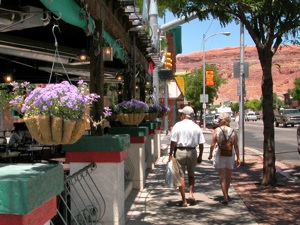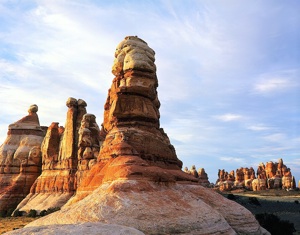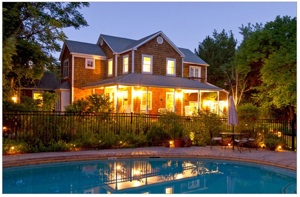
North and South Windows at Arches National Park/Rebecca Latson
Sandstone so porous it absorbs the sun's rays?
It certainly seems that way as I head into Arches National Park, where the iron-rich sandstone stands stained red against the sky, a three-dimensional pleine air art gallery of earth tones.
Negotiating Park Avenue, your neck gets a constant workout as you find yourself gazing right and left and up and down at the soaring ramparts. You walk past the formation that rightly deserves to be known as Nefertiti, and are welcomed by the local inhabitants -- darting lizards that scurry about this broken down landscape.
The geologic collapse continues across Highway 191 in Canyonlands National Park, where you'll also find some nice arches, but be blown away over the breadth, depth, and hue of the eroding landscape. These snaking canyons, carved by the Colorado and Green rivers that seem so small and inconsequential when viewed from Grandview or Green River overlooks, are among the most incredible voids you'll find.
So expansive and alluring, these two redrock kingdoms require a good base-camp where you can recuperate after long days out in the sun, and Moab offers just that. It still has the gritty edge of the mining town it was once, but these days it's so much more accommodating to out-of-towners with great accommodations and surprising eateries.
Scratch beneath the surfaces of these two parks, and spend time in their gateway, and you just might come away believing the sun really did stain the landscape here.
Where Should You Go?
Arches can be a very straightforward, one day and done, park experience. You pass through the entrance station, stop at the Visitor Center to top off your water bottles, then head up the hill.

Balanced Rock is a consistent crowd pleaser in Arches National Park. Kurt Repanshek photo.
You pass Park Avenue, go on to Courthouse Towers, Balanced Rock, and the Windows Section. Then it's off to Devil's Garden and the hike to Landscape Arch, (which, at last check, was still standing), a quick lunch, and then doubleback with a stop and perhaps a hike to Delicate Arch, and you're done, right?
You might even have enough time to drive over to Island in the Sky in Canyonlands for a glance through Mesa Arch.
But Arches deserves so much more of your attention. You need to take the time to walk the mile down Park Avenue, taking time to notice not only the way the sun glints off the slabs of red stone but also to examine the vegetation that somehow manages to survive in this arid setting, to see the powdery dust that passes as soil.
You must go beyond Landscape Arch. The walk from the parking lot to this sinuous span of rock is short, you'll barely work up a sweat, even in July. And there's so much more to see. You can spend a half-day exploring beyond Landscape Arch, going beyond Navajo Arch and the rubble that remains after the collapse in 2008 of Wall Arch, all the way to Double O arch and Dark Angel pillar. And then, leave behind what little crowd might have followed you and vanish into the desertscape by taking Primitive Trail back to Landscape Arch.
This hike not only draws you deeper into the park and deeper into the red-rock, but it tests your fear of heights as you climb up onto fins of stone that might one day form arches and walk along their spines. Those who go beyond the Caution, Primitive Trail, Difficult Hiking sign will find themselves touring the basement of Arches. You scurry across thin fins of rock still being whittled by erosion, and snake through narrow passageways between the fins. At times you negotiate around potholes filled from recent rains, and stroll down dusty washes, ever watchful for small cairns of rocks that slowly but surely lead you back to the main trail near Landscape Arch.
Walking down into the landscape is one thing, but what would you think about descending into it by rope? There's a company in Moab, Desert Highlights, where the guides are ready to put you on that rope and dangle you in the air during a 100-foot (30.5-m) descent.
Other Great Ways To Experience Arches?
* Park your car at the Windows Section, take the short trail that leads you out into the desert surrounding the Windows, hike up into Turret Arch, and be sure to make the walk, also short, over to Double Arch.
* Best of all, and almost as great as canyoneering through the park, schedule your visit for the dark nights of the new moon so you can hike the mile-and-half (2.4 km) to Delicate Arch under blazing starlight and gaze at the Milky Way from beneath those chaps of stone. Not only will you miss the crowds normally found en route to this arch during the high season, but you'll also miss summer's high heat and experience an astronomical setting few people see.
* If you're comfortable driving in sand, head out to Klondike Bluff where you'll find not only spectacular rock formations but also dinosaur tracks. Another arch, Tower, also is in this area of the park. To get there, just before reaching Devils Garden turn left onto the Salt Valley Road and drive 7.2 miles (11.59 km) to another left-hand turn that leads you 1.1 miles (1.77 km) to a parking area. From there you can roam around the "Marching Men" nearby or hike 1.7 miles (2.7 km) to Tower Arch. Keep an eye on the weather, though, as rainstorms can wreak havoc with the Salt Valley Road, and you don't want to pay for a tow outta there.

Downtown Moab features a good number of restaurants and gift shops. Photo courtesy of Moab Area Travel Council.
Canyonlands, Short Or Long
Canyonlands can be quickly sampled if you can't settle into Moab and spend a few days exploring.
The ride to the Island in the Sky from downtown is about a half hour, a ride that offers a great display of the tortured landscape here. Looking north, you wouldn't think the landscape drops precipitously anywhere around you, but that's one of the surprises of Canyonlands. (Tip: On your way, you'll pass a turnoff to Dead Horse Point State Park, a great side trip for an incredible view down onto the goosenecks made by the Colorado River. There's also a nice campground here.)
On its face, Island in the Sky can be quickly checked off: Mesa Arch, Buck Canyon Overlook, Grandview Overlook, and Green River Overlook. But that would deprive you of getting a better understanding of this mesa. Go to Whale Rock, park your car, and walk up onto its back. From there you'll get not only a great view of the surrounding landscape, but also down into Upheaval Dome, the creation of which has long baffled scientists. Some think the collapse of a salt dome created this massive depression, others think a meteorite did the job.
After Whale Rock, take the short hike to Aztec Butte, walk around its rim, and in places go below it, to check out ancient Puebloan graneries. Some are in disarray, time having dismantled them, but others have been repaired to give you an idea of how they once appeared.
Get out of your car at Shafer Canyon Overlook just to stun yourself at the thought that mining trucks once negotiated the Shafer Trail Road below. These days the main mode of transportation on this dirt track is mountain bike, and many explore the 100-mile-long (160/9 km) White Rim Trail for several days, with a sag wagon toting their gear, a mini-repair shop, and vittles.
Set Aside Several Days For Canyonlands
To really appreciate Canyonlands, you need a few more days, and a willingness to rise early. The Needles District is some 70 miles (112.65 km) south of Moab, but it's definitely worth the drive. Pack a lunch (or pick a box lunch up at the Red Rock Bakery and Cafe at 74 South Main), and head for the Needles while the sun is still low in the east.
Once there, make the complete tour. Drive to Big Spring Overlook and get out and take a short hike to gaze into the rocky cleft below, hike the short (2.4 miles / 3.86 km, roundtrip) Slickrock Trail to appreciate what slick rock is, and to glimpse, if you're truly fortunate, some desert bighorn sheep. Perhaps the best trail in this district is the Elephant Hill Trail, which leads you....as far as you want to go, pretty much.

Chesler Park in Canyonlands harbors some of the most unusual geology you'll ever set eyes on. NPS photo.
This trail leads from a small (get there early in the day or you could have a difficult time finding a place to park), dusty parking area up onto a landscape framed by minarets, boulders, and cliffs.
You could find yourself spending all day exploring the backcountry that the Elephant Hill Trail takes you too....or you could sign up with Adrift Adventures for a backcountry excursion by four-wheel drive on old mining roads. These multi-day expeditions will take you to more Native American ruins and rock art panels and introduce you to more of the park's incredible geology.
But you don't need to disappear into the backcountry to enjoy the Needles District. The spectacular landscape surrounds you, and a number of short hikes takes you to some pretty cool places. The Cave Spring Trail leads you to an early 20th century cowboy camp tucked into an alcove. An adjacent alcove has prehistoric rock art in the form of handprints. The Pothole Point Trail takes you past potholes that fill with water when storms roll through; short elevation gains on this hike provide sweeping views.
(Tip: Either on your way to the Needles, or on the way back, stop at Newspaper Rock State Historic Site. It's right off Utah 211 that leads you to the Needles. Here you'll find an amazing collage of 2,000 or so years of rock art left by Native Americans.)
Perhaps the most difficult aspect of wanting to see all parts of Canyonlands in one visit is finding enough time to also get down into the water on a raft or explore the Great Gallery in the Maze District.
The gallery was left behind by nomadic tribes that would wander the canyons from camp to camp. Trek down into it and you'll find the “Holy Ghost” hovering above a sandy wash. Surrounded by lesser figures, the striking specter nearly eight feet tall shimmers on the canyon wall under the relentless sun. Some archaeologists believe these images are more than 7,000 years old.
You can lead your own hike to the Great Gallery -- once you've negotiated the 2.5-hour drive from Moab, a drive that includes 30 miles (48.3 km) along the dirt, at times washboard weary Hans Flat Road.
From the trailhead, the walk to the Great Gallery is an easy three-and-a-quarter miles (6.04 km) one way through a sandy wash. There are several other rock art panels worth examining on your walk to the gallery, and the Park Service has them well-marked. In the past, rangers have led walks to the Great Gallery every Saturday morning at 9 a.m. from April into October. Check with the park -- 435-719-2313 -- before you go, but you can easily handle this walk on your own.
Holiday River Expeditions is one of the companies that offers float trips on the Colorado River through Canyonlands, and also can combine mountain biking with your journey by water.
(Tip: While the White Rim Trail that winds through Canyonlands is one way to explore this wondrous landscape from the saddle of your mountain bike, you'd be remiss if you came all the way to Arches and Canyonlands with your bike and didn't experience the Slickrock Bike Trail just east of Moab. Though there are only about 10.5 miles (16.9 km) of bike trail here, those miles rate a "4" on a scale of 1-4, with 4 being the most difficult. To that point, there's a 2-mile (3.2 km) practice loop to help you get accustomed to riding on undulating sandstone. You can find many other biking trails in the region at this site.)
Doing The Town Right: Lodging And Eats
Where do you go to call it a night? There are plenty of chain motels along the main drag that goes through Moab, but if you're a little more adventurous, or are looking for a more pampering experience, look beyond main street.

The Sunflower Hill Bed & Breakfast is hidden in the backstreets of Moab. Courtesy photo.
Sunflower Hill is the most venerable bed-and-breakfast in Moab, and deservedly so. Hidden on a backstreet on the east side of town, this charming B&B has a number of outbuildings, centered around a relaxing patio and pool, where you can enjoy the peaceful Southwestern nights with stars aplenty overhead.
Several blocks to the south you'll find the Cali Cochitta B&B, which is ensconced in a late 1800s Victorian house that the owners have restored into a comfortable waystation. Two enticing cottages provide a little more peace and quiet.
If you don't mind a 30-minute drive, the Sorrel River Ranch should be your destination. True, you'll pay for it -- nightly rates quickly rise past $400 a night and climb towards $700 if you're looking for a family unit -- but the accommodations on this 160-acre spread arguably are the best in the area. There's a restaurant on site, a spa, and you can even bring your horse. An off-day from exploring the two parks is deliciously spent relaxing at the ranch, which backs up to the Colorado River, making it possible to spend a refreshing afternoon going downstream in a "rubber ducky."
For an overview on lodging options in the Moab area, check out this page.
Where Can You Refuel?
Staying in Moab requires you to find meals, and that isn't hard to do.
Perhaps the best breakfast is served at the Jailhouse Cafe, where the menu features a nice range of egg dishes -- omelets, scrambles, and florentines -- and a favorite, ginger pancakes topped with Dutch apple butter. A side of bacon might not be what the doctor ordered, but it's thick and salty and will help keep you going on your way to Delicate Arch.
Dinners run the gamut from pizza and beer to high-end establishments where they pamper you with service and entrees you would expect to find in San Francisco or New York.
One of my favorites is the Desert Bistro at 36 South, 100 West. Owners Karl and Michelle Kelley know a thing about needing to refuel after a day in the desert. Both are climbers who spend their days literally gripping the landscape, and their nights ensuring you'll eat a great meal from a seasonally-changing menu.

The Desert Bistro has moved around town over the years, but the chef remains the same.
Other options around town include Miguel's Baja Grill, a local's favorite squeezed into a narrow corridor on main that serves Mexican dishes that are not overloaded with cheese and refried beans. If you want to catch the sunset while dining, drive up to the Sunset Grill where the wall of west-facing windows guarantees you'll catching the waning rays.
There's great food and comfy, sophisticated accommodations to savor in Moab, but the richest dish/experience is found when you take the time to do this area right, and delve into settings (not to mention geology and history) that are among the grandest sights in the United States.
Where Can You Refuel ... Your Vehicle?
Of course there are gas stations in Moab. But, what if you are driving an electric vehicle (EV)? Moab supports several EV charging stations as does the community of Green River, 52 miles (83.7 km) northwest of Moab.





